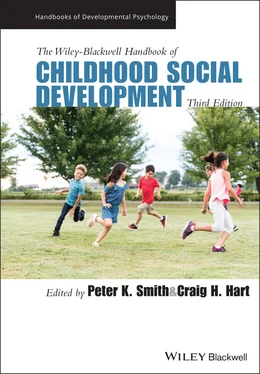34 Hong, J. S., Kim, D. H., Thornberg, R., Kang, J. H. & Morgan, J. T. (2018). Correlates of direct and indirect forms of cyberbullying victimization involving South Korean adolescents: An ecological perspective. Computers in Human Behavior, 87, 327–336.
35 Hong, J. S., Lee, C. H., Lee, J., Lee, N. Y., & Garbarino, J. (2014a). A review of bullying prevention and intervention in South Korean schools: An application of the social‐ecological framework. Child Psychiatry and Human Development, 45(4), 433–442.
36 Hong, J. S., Peguero, A. A., Choi, C., Lanesskog, D., Espelage, D. L., & Lee, N. Y. (2014b). Social ecology of bullying and peer victimization of Latino and Asian Youth in the United States: A review of the literature. Journal of School Violence, 13(3), 315–338.
37 Iyer‐Eimerbrink, P., & Jensen‐Campbell, L. A. (2019). The long‐term consequences of peer victimization on physical and psychological health: A longitudinal study. Journal of Applied Behavioral Research, 24(4), 1–20.
38 Johnstone, L., & Dallos, R. (2014). Formulation in psychology and psychotherapy: Making sense of people’s problems (2nd ed.). Routledge.
39 Jones, C., Whitfield, C., Seymour, J., & Hayter, M. (2019). “Other girls”: A qualitative exploration of teenage mothers’ views on teen pregnancy in contemporaries. Sexuality & Culture, 23(3), 760–773.
40 Köster, M., Cavalcante, L., Cruz de Carvalho, R. V., Resende, B. D., & Kärtner, J. (2016). Cultural influences on toddlers’ prosocial behavior: How maternal task assignment relates to helping others. Child Development, 87(6), 1727–1738.
41 Lambe, L. J., Della Cioppa, V., Hong, I. K., & Craig, W. M. (2019). Standing up to bullying: A social ecological review of peer defending in online and offline contexts. Aggression and Violent Behavior, 45, 51–74.
42 Lee, C. (2011). An ecological systems approach to bullying behaviors among middle school students in the United States. Journal of Interpersonal Violence, 26(8), 1664–1693.
43 Lickenbrock, D. M., & Braungart‐Rieker, J. M. (2015). Examining the antecedents of infant attachment security with mothers and fathers: An ecological systems perspective. Infant Behavior and Development, 39, 173–187.
44 Livingstone, S., & Ross, A. (2020). Parenting for a digital future: How hopes and fears about technology shape children’s lives. Oxford University Press.
45 Maunder, R., & Crafter, S, (2018). School bullying from a sociocultural perspective. Aggressive & Violent Behavior, 38(1), 13–20.
46 Mazur, J., Tabak, I., & Zawadzka, D. (2017). Determinants of bullying at school depending on the type of community: Ecological analysis of secondary schools in Poland. School Mental Health, 9(2), 132–142.
47 Meadows, S. (2018). Understanding child development: Psychological perspectives and application. Routledge.
48 Mitsopoulou, E., & Giovazolias, T. (2015). Personality traits, empathy and bullying: A meta‐analytic approach. Aggression & Violent Behavior, 21, 61–72.
49 Newman, P. A., & Fantus, S. (2015). A social ecology of bias‐based bullying of sexual and gender minority youth: Toward a conceptualization of conversion bullying. Journal of Gay & Lesbian Social Services, 27(1), 46–63.
50 Olweus, D. (1997). Bully/victim problems in school: Facts and intervention. European Journal of Psychology of Education, 12(4), 495–510.
51 Patton, D. U., Hong, J. S., Williams. A. B., & Allen‐Meares, P. (2013). A review of research on school bullying among African American youth: An ecological systems analysis. Educational Psychology Review, 25(2), 245–260.
52 Pitsia, V., & Mazzone, A. (2020). The association of individual and contextual variables with bullying victimisation: A cross‐national comparison between Ireland and Lithuania. European Journal of Psychology of Education. https://doi.org/10.1007/s10212‐020‐00514‐0
53 River, L. M., Borelli, J. L., & Nelson‐Coffey, K. (2019). Tolerance of infant distress among working parents: Examining the roles of attachment anxiety and work‐family conflict. Parenting: Science and Practice, 19(1–2), 137–159.
54 Salmivalli, C., Lagerspetz, K. M. J., Bjorqvist, K., Osterman, K., & Kaukiainen, A. (1996). Bullying as a group process: Participant roles and their relations to social status within the group. Aggressive Behavior, 22(1), 1–15.
55 Saarento, S., & Salmivalli, C. (2015). The role of classroom peer ecology and bystanders’ responses in bullying. Child Development Perspectives, 9(4), 201–205.
56 Savahl, S., Monsterrat, C., Casas, F., Adams, S., Tiliouine, H., Benninger, E., & Jackson, K. (2019). Children’s experiences of bullying victimization and the influence on their subjective well‐being: A multinational comparison. Child Development, 90(2), 414–431.
57 Sette, G., Coppola, G., & Cassibba, R. (2015). The transmission of attachment across generations: The state of art and new theoretical perspectives. Scandinavian Journal of Psychology, 56(3), 315–326.
58 Singh, S., & Naicker, P. (2019). Development of resilience in teenage mothers within contextual realities of poor rural South Africa. Journal of Poverty, 23(7), 559–572.
59 Smith‐Darden, J., Kernsmith, P. D., Victor, B. G., & Lathrop, R. A. (2017). Electronic displays of aggression in teen dating relationships: Does the social ecology matter? Computers in Human Behavior, 67, 33–40.
60 Smith, P.K., & Berkkun, F. (2020). How prevalent is contextual information in research on school bullying? Scandinavian Journal of Psychology, 61(1), 17–21.
61 Solomon, J., & George, C. (1996). Defining the caregiving system: Toward a theory of caregiving. Infant Mental Health Journal, 17(3), 183–197.
62 Sroufe, L. A. (2005). Attachment and development: A prospective, longitudinal study from birth to adulthood. Attachment & Human Development, 7(4), 349–367.
63 Swearer, S. M., & Doll, B. (2001). Bullying in schools: An ecological framework. Journal of Emotional Abuse, 2(2), 7–23.
64 Swearer, S. M., & Hymel, S. (2015). Understanding the psychology of bullying: Moving toward a social‐ecological diathesis‐stress model. American Psychologist, 70(4), 344–353.
65 Thompson, R. A. (2021). Eyes to see and ears to hear: Sensitivity in research on attachment and culture. Attachment & Human Development, 23(2), 222–230.
66 Tudge, J., Gray, J. T., & Hogan, D. M. (1996). Ecological perspectives in human development: A comparison of Gibson and Bronfenbrenner. In J. Tudge, M. J. Shanahan, & J. Valsiner (Eds.), Comparisons in human development (pp. 72–105). Cambridge University Press.
67 Vaughn, B., Egeland, B., Sroufe, L. A., & Waters, E. (1979). Individual differences in infant‐mother attachment at 12 and 18 months: Stability and change in families under stress. Child Development, 50(4), 971–975.
68 Volling, B. L. (2020). Widening the lens on family processes and the development of parent‐child attachment relationships. Attachment & Human Development, 22(1), 124–128.
69 Weerasekera, P. (1993). Formulation: A multiperspective model. Canadian Journal of Psychiatry, 38(5), 351–358.
70 Weisner, T. S. (2005). Attachment as a cultural and ecological problem with pluralistic solutions. Human Development, 48(1–2), 89–94.
71 Yoo, J. A. (2019). Ecological factors influencing parenting behaviors during adolescence: A focus on monitoring, attachment, and harsh discipline. Children and Youth Services Review, 101, 246–254.
Конец ознакомительного фрагмента.
Текст предоставлен ООО «ЛитРес».
Прочитайте эту книгу целиком, купив полную легальную версию на ЛитРес.
Читать дальше












